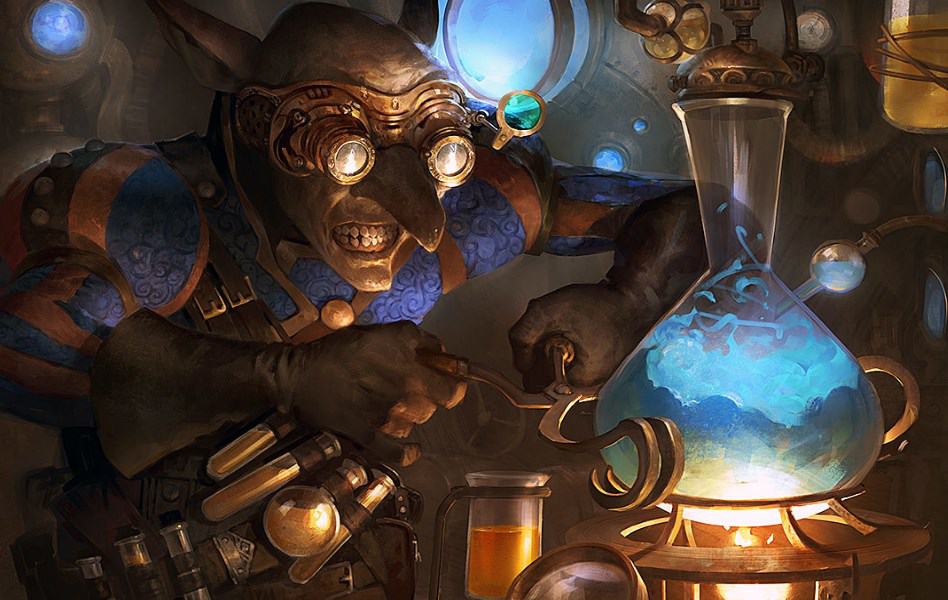Artificers are an unusual class in D&D 5e. A blend of magic and technology, the Artificer has a strong ‘steampunk’ feel in comparison to the traditional medieval-inspired classes found elsewhere in D&D. But that’s what makes Artificers such a cool class. So you now want to know how to play an Artificer in 5e. Well, in this guide we’ll cover everything you need to know.
Here’s what’s in this Artificer 5e Guide:
- What are Artificers in 5e?
- How to create an Artificer character
- Artificer spells
- Artificer specialists
- Frequently asked questions
What are Artificers in 5e?
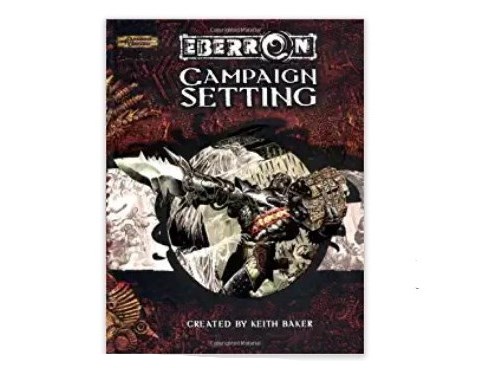
In a dark and dangerous dungeon, you and your companions can feel the silence of the place. No living thing has roamed this deep into the dungeon for centuries. With a click of her fingers, the Artificer produces a small metal contraption that buzzes above you and emits a warm, comforting light. But the light reveals other horrors – skeletons begin emerging from the corners of the room.
You hear the clank of metal behind you, but it does not scare you. It is the Artificer’s steel defender, a great metallic bear that crushes the skeletons to dust in moments.
One of your parties, however, was injured in the scuffle. The Artificer opens her leather jacket to reveal an array of strangely colored potions and ointments. She grabs a jar of purple cream and dabs it on your companion’s wound and you watch in amazement as the cuts close up within seconds.
The Artificer is a spell-caster, but a very different one than Sorcerers, Clerics, or Druids. Like Sorcerers, Artificers draw on Arcane magic, but their methods are very different. Artificers see magic as a tool to be used in their inventions and remedies. So although Artificers use magic, their practice is closer to that of inventors, alchemists, and artisans, than the mystical work of Sorcerers.
Artificers were once a Wizard subclass in D&D 2e. Over time, they have been associated with the Eberron Campaign Setting as expert magic-item makers. The most recent version of the Artificer, however, is found in Tasha’s Cauldron of Everything.
How to create an Artificer character
What are the Artificer’s statistics?
The Artificer’s primary statistic in 5e is Intelligence. If you want to play an Artificer, Intelligence should be your highest stat, followed by Dexterity or Constitution.
What are the Artificer’s characteristics?
- How many hit points do Artificers get?
Artificers start with 8 hit points plus their Constitution modifier. After 1st level, Artificers get an additional 1d8 worth of hit points per level. - What armor can Artificers wear?
Artificers can wear light or medium armor and they can carry shields. - What weapons can Artificers use?
Artificers have proficiency in simple weapons (clubs, maces, spears). They can also use ranged weapons. - What tools can Artificers use?
Artificers can use thieves’ tools, tinkers’ tools, and one type of artisan tool of the player’s choice. - What saving throws are Artificers proficient in?
Constitution and Intelligence. So if you’re asked to do a saving throw as an Artificer, you’ll use either your Constitution or Intelligence modifier. - What skills do Artificers have?
At 1st level, Artificers can choose two of the following skills: Arcana, History, Investigation, Medicine, Nature, Perception, or Sleight of Hand. - What equipment do Artificers start with? All classes have starting equipment. Artificers start with any two simple weapons of your choice, a light crossbow and 20 bolts, your choice of studded leather armor or scale mail,
thieves’ tools, and a dungeoneer’s pack.
What special abilities do Artificers have?
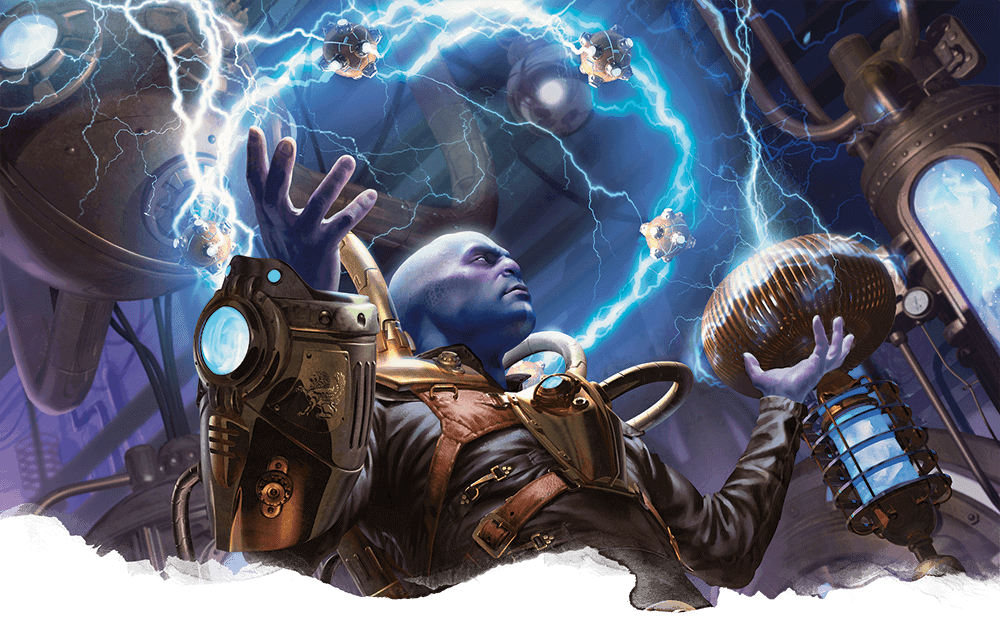
Magical Tinkering
Artificers can use thieves’ tools or tinkers’ tools to invest magic into small, mundane objects. By touching a tiny non-magical object, Artificer’s use Magical Tinkering as an action to give the object one of the following magic properties:
- The object emits a 5ft radius bright light.
- The object will emit a recorded message of up to 6 seconds whenever tapped.
- The object emits an odor or non-verbal sound of your choice (e.g. birds tweeting, footsteps).
- A visual effect is shown on the object – this can be images, words, shapes, or a combination of any of the three.
The effect lasts indefinitely and the number of objects you can use Magical Tinkering on is equal to your Intelligence modifier (or one if you do not have a positive Intelligence modifier).
Artificer Infusions
From the 2nd level onwards, Artificers can imbue objects with magic using infusions after a long rest. At 2nd level, Artificers can choose four from the following list of infusions:
- Armor of Magical Strength: A suit of armor is given six charges which refresh 1d6 of charges each morning. Using these charges the wearer can add a bonus to Strength checks or saving throws using their intelligence modifier or prevent themselves from being knocked prone.
- Enhanced Arcane Focus: A rod, staff, or wand can be imbued so that whoever wields it gets a +1 bonus to spell attack rolls.
- Enhanced Defense: A suit of armor or shield is imbued so that whoever wears/holds it gets a +1 to their armor class.
- Enhanced Weapon: A simple or martial weapon becomes a magical weapon and grants a +1 to the wielder’s hit and damage rolls.
- Homunculus Servant: The Artificer creates a small magical, mechanical creature. The hit points and damage dealt by this creature will depend on the Artificer’s Intelligence and spell attack modifiers.
- Mind Sharpener: The wearer of this armor or robe can use one of its four charges to succeed on a failed Constitution saving throw used to maintain concentration during a spell.
- Repeating Shot: A simple or martial ammunition weapon becomes magical and grants a +1 bonus on attack and magic rolls to its user. The weapon will also produce its own ammunition if it is not already loaded.
- Replicate Magic Item: You can replicate certain magic items depending on your level. At the 2nd level, for example, you can replicate an alchemy jug, a bag of holding, a cap of water breathing, goggles of night, a rope of climbing, sending stones, a wand of magic detection, and a wand of secrets.
- Returning Weapon: A simple or martial weapon that can be thrown becomes magical, grants a +1 bonus to attack and damage rolls, and will return to the user’s hand immediately after use.
There are more Artificer infusions that can only be learned at certain levels. The Artificer’s level also determines how many items they can have infused at once. The full details of these and in-depth rules as to how infusions work can be found in Tasha’s Cauldron of Everything.
Leveled up abilities
Artificers get a range of new abilities as they level up. These include:
- Artificer Specialist: From the 3rd level, Artificers can choose a type of specialist (see more details below). They can choose from Alchemist, Armorer, Artillerist, or Battle Smith.
- The Right Tool for the Job: 3rd level Artificers can use thieves’ tools or artisans’ tools to spend 1 hour magically creating another set of artisans’ tools.
- Ability Score Improvement: Artificers can increase one ability score by 2 or two ability scores by 1 at the 4th, 8th, 12th, 16th, and 19th levels.
- Tool Expertise: At the 6th level and above, an Artificer’s proficiency bonus is doubled for any ability check made using their proficiency with a tool.
- Flash of Genius: From the 7th level, if you or a nearby creature must make a saving throw or ability check, you can add your Intelligence modifier to the roll.
Artificer Spells
Artificers know how to channel magic through objects, so their spellcasting abilities appear to others as the result of mechanical inventions. Artificers must use a spellcasting focus for their spells, which is usually thieves’ tools or artisans’ tools. At the 2nd level, however, Artificers can also use one of their infused items (see above) as a focus. Artificers use their Intelligence modifier for their spellcasting ability.
The full list of Artificer spells 5e can be found in Tasha’s Cauldron of Everything, but here is our list of the best level 1 Artificer spells:
- Disguise self: Your appearance, including your body, clothing, armor, and weapons, look different for 1 hour. You cannot completely change your body (i.e. you must be something with the same general shape, i.e. two legs, two arms, humanoid), and the spell is illusory so may fail to trick others on close inspection.
- Identify: You learn the properties of a magic item or magic-imbued item through touch.
- Cure wounds: A creature you touch gains 1d8 plus your spellcasting ability modifier (Intelligence) worth of hit points.
What are Artificer cantrips?
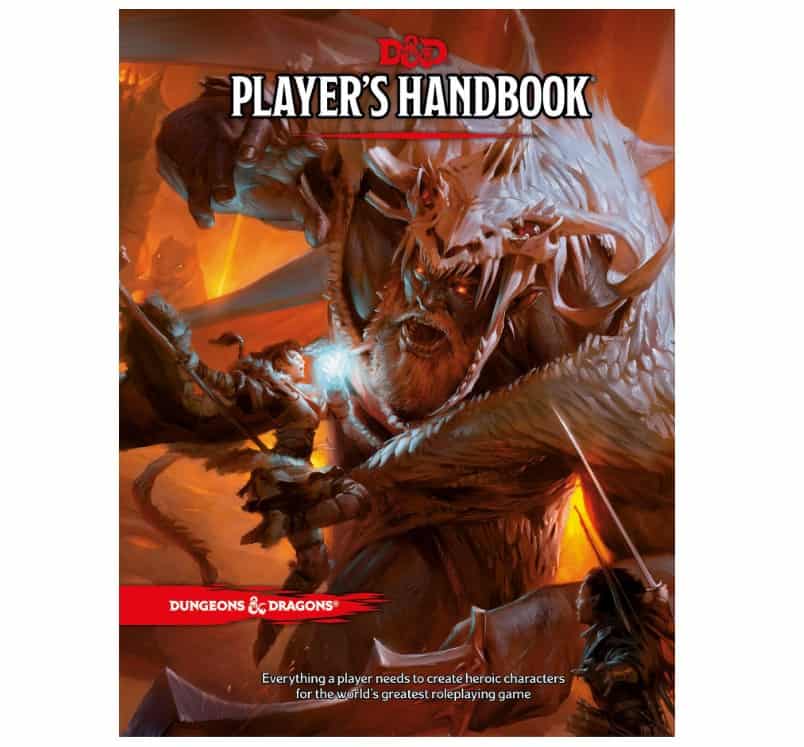
In addition to their spells, Artificers begin with two cantrips. Cantrips are spells that can be cast at any time, multiple times a day, without the need for preparation. As Artificers level up, they get access to more cantrips. The Artificer cantrips included in the Player’s Handbook are:
- Acid splash: You throw a bubble of acid at 1-2 targets. If they fail a Dexterity saving throw, they take 1d6 acid damage.
- Dancing lights: You create up to four torch-sized glowing lights. These can appear as beams, orbs, or combined to make a humanoid-shaped light.
- Firebolt: As a ranged attack, you throw a mote of fire at a target. That target takes 1d10 fire damage.
- Guidance: By touching one creature, they can roll 1d4 and add that to one ability check of their choice.
- Light: An object you touch emits bright light in a 20ft radius.
- Mage hand: A floating hand appears within 30ft of you. This can be used to manipulate objects – such as opening doors or lifting small objects.
- Mending: You can repair a single break or tear (no more than 1ft in its dimension) in an object that you touch.
- Message: A creature within 120ft of you can hear a message that you whisper and reply back to you.
- Poison spray: You can target a nearby creature with a puff of poisonous gas. That creature must make a Constitution test and, if they fail, take 1d12 poison damage.
- Prestidigitation: You can create one of the following magical effects within 10ft:
- A harmless sensory effect such as an odor, quiet music, a puff of wind, or a brief spark.
- You can light or extinguish a candle, torch, or small campfire.
- You can clean or soil an object no larger than 1 cubic square foot.
- You can make a color, symbol, or mark appear on an object for 1 hour.
- Ray of frost: A solid beam of cold, blue light will hit a creature in range on a successful ranged attack. The creature hit will take 1d8 cold damage.
- Resistance: You touch a willing creature and for the next minute they can add 1d4 to one saving throw of their choice.
- Shocking grasp: Using a melee attack, you can shock a creature with lightning. Your attack roll will have advantage if the target is wearing metal armor. If hit, the target takes 1d8 lightning damage and won’t be able to react until the start of its next turn.
- Spare the dying: A living creature on 0 hit points can be touched to recover and become stable.
- Thorn whip: You create a 30ft thorny whip, with which you can make a spell melee attack on a creature who, if you hit, takes 1d6 piercing damage. You can also use the whip to pull the creature closer to you.
There are additional cantrips that Artificers can use in Tasha’s Cauldron of Everything and Xanathar’s Guide to Everything.
Artificer Specialists
What are Artificer specialists? At 3rd level, Artificers choose a specialism, which is essentially a subclass. D&D 5e has four official specialists: Alchemist, Armorer, Artillerist, and Battle Smith. We’ll discuss each of these specialists below, but if you’re feeling adventurous, you could check out these 10 homebrew Artificer specialists.
Alchemist
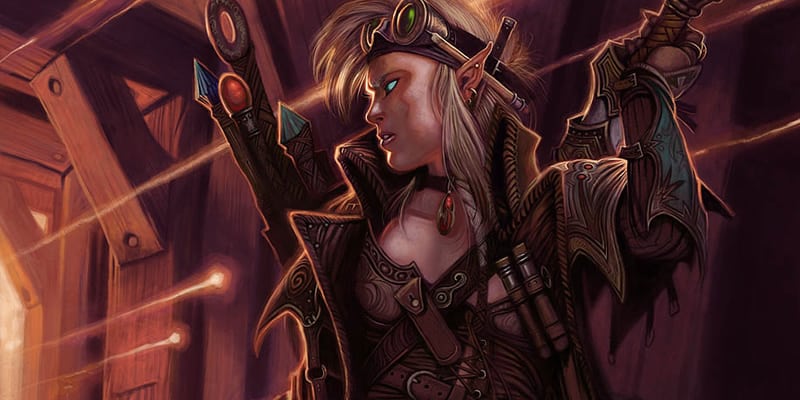
Alchemy is the oldest Artificer practice and involves the arts of combining strange substances and mysterious chemicals to create wondrous potions and elixirs.
What tools can Alchemists use in 5e?
At 3rd level, Artificers who choose the Alchemist specialist gain proficiency with alchemists’ supplies.
What are the Alchemist spells in 5e?
At certain levels, Alchemists get access to alchemist spells. These are:
-
- 3rd level: healing word, a ray of sickness
- 5th level: flaming sphere, Melf’s acid arrow
- 9th level: gaseous form, mass healing word
- 13th level: blight, death ward
- 17th level: cloudkill, raise dead
What can Alchemists make in 5e?
At certain levels, Alchemists can make certain potions and elixirs. These are:
- 3rd level: Experimental Elixir – Use alchemists’ supplies and roll 1d6 to make one of the following potions:
- 1: Healing
- 2: Swiftness
- 3: Resilience
- 4: Boldness
- 5: Flight
- 6: Transformation
- 5th level: Alchemist Savant – Whenever you cast a spell using alchemists’ supplies as your focus, you get a bonus equal to your Intelligence modifier to one roll of the spell. This roll must be used to restore hit points or to deal one of the following damage types: acid, fire, necrotic, or poison.
- 9th level: Restorative Reagents – You use your knowledge of healing potions to gain the following features:
- Anyone who drinks one of your Experimental Elixirs gains temporary hit points equal to 2d6 + your Intelligence modifier.
- Using alchemists’ supplies as a focus, you can cast lesser restoration without needing to prepare it or using a spell slot.
- 15th level: Chemical Mastery – You gain resistances to certain chemicals, giving you the following features:
- You are resistant to acid and poison damage.
- You are immune to poison.
- Using alchemists’ supplies as a focus, you can cast greater restoration and heal without material components, preparing, or using a spell slot.
Armorer
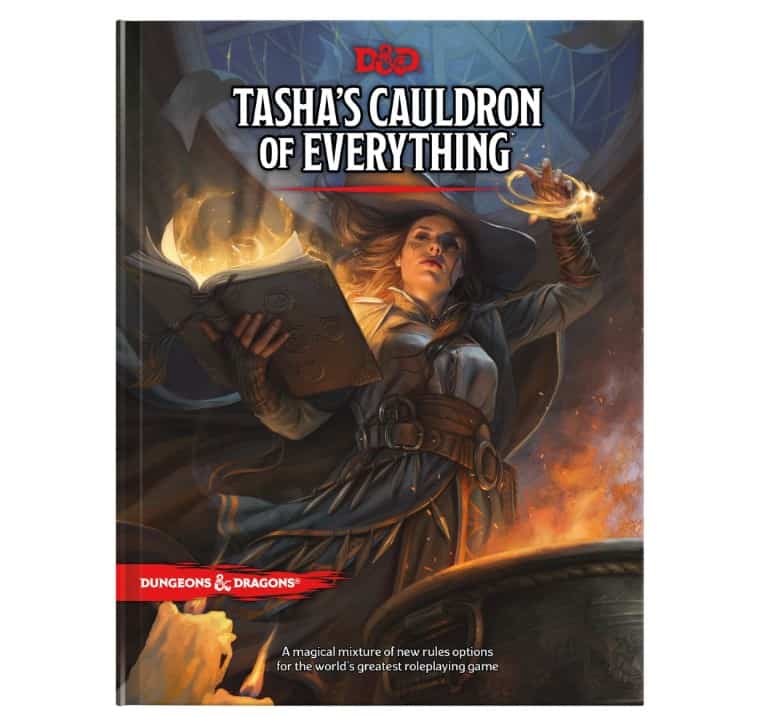
Tasha’s Cauldron of Everything describes the Armorer as able to modify armor so that it functions ‘almost like a second skin’. Armorers have a close, visceral relationship with the armor they create.
What tools can Armorers use in 5e?
At the 3rd level, Artificers who choose the Armorer specialist gain proficiency with heavy armor and smiths’ tools.
What are the Armorer spells in 5e?
At certain levels, Armorers get access to armorer spells. These are:
- 3rd level: magic missile, thunderwave
- 5th level: mirror image, shatter
- 9th level: hypnotic pattern, lightning bolt
- 13th level: fire shield, greater invisibility
- l7th level: passwall, wall of force
What can Armorers make in 5e?
At certain levels, Armorers can make certain types of armor. These are:
- 3rd level: Arcane Armor – Using smiths’ tools, you can upgrade a suit of armor that you are currently wearing into Arcane armor. This armor gains the following features:
- The armor has no Strength requirement
- The armor can be used as a spellcasting focus for your spells
- The armor is attached to you and cannot be removed against your will
- The armor replaces any missing limbs and functions as a metal prosthetic
- 3rd level: Armor Model – You can customize your armor and give it a special weapon, which, when attacked with, has your Intelligence (rather than Strength or Dexterity) added to attack and damage rolls. You can choose from the following two customizations:
- Guardian: Armor designed to be in the frontline with the following features:
- Thunder Gauntlets: Both of the armor’s gauntlets count as simple weapons so long as you aren’t holding anything in that hand. The gauntlets deal 1d8 thunder damage.
- Defensive Field: You can take a bonus action to gain temporary hit points equal to your level. This can be used as many times as equal to your proficiency bonus and you regain all uses when your long rest.
- Infiltrator: Armor designed for stealth and ranged attacks with the following features:
- Lightning Launcher: A gem appears on your fist or chest and functions as a simple ranged weapon. The gem deals 1d6 lightning damage.
- Powered Steps: Your walking speed increases by 5ft.
- Dampening Field: You have an advantage on Stealth checks.
- Guardian: Armor designed to be in the frontline with the following features:
- 5th level: Extra Attack – You can attack twice rather than once whenever you take an attack action.
- 9th level: Armor Modifications – Your Arcane Armor now counts as separate pieces for the purposes of your Infuse Items ability (see above). In other words, your chest piece, boots, helmet, and special weapon count as separate objects that can bear different infusions.
- 15th level: Perfected Armor – Your Arcane Armor gains a new feature:
- Guardian: You can force a nearby (within 30ft) creature to make a Strength saving throw against your spell save DC (difficulty class). If it fails, you can pull that creature up to 30ft towards you. If you pull it to within 5ft of you, you can make a melee attack.
- Infiltrator: If a creature takes damage from your Lightning Launcher it will glow until the start of your next turn. This gives the creature disadvantage on any attacks made on you. It also gives you an advantage on attacks against that creature and if you hit you will deal an additional 1d6 lightning damage.
Artillerist

Artillerists specialize in projectiles and explosives, making them valuable allies in combat.
What tools can Artillerists use in 5e?
At 3rd level, Artificers who choose the Artillerest specialist gain proficiency with woodcarvers’ tools.
What are the Artillerist spells in 5e?
At certain levels, Artillerists get access to artillerist spells. These are:
- 3rd level: shield, thunderwave
- 5th level: scorching ray, shatter
- 9th level: fireball, wind wall
- 13th level: ice storm, wall of fire
- 17th level: cone of cold, wall of force
What can Artillerists make in 5e?
- 3rd level: Eldritch Cannon – Once in between long rests, Artillerists can use woodcarvers’ tools or smiths’ tools to make a small or tiny magical cannon. This cannon has an AC of 18 and hit points equal to five times your level. You can make one of the following cannons:
- Flamethrower: Creatures that fail a Dexterity saving throw against your spell save DC take 2d8 fire damage (or half that on a successful saving throw).
- Force Ballista: On a successful ranged spell attack, your cannon does 2d8 force damage on the target and pushes it 5ft away from the cannon.
- Protector: The cannon emits magical energy that grants itself and creatures of your choice within 10ft temporary hit points equal to 1d8 plus your Intelligence modifier.
- 5th level: Arcane Firearm – Using woodcarvers’ tools, you can turn a wand, staff, or rod into an Arcane Firearm. When you cast a spell through this firearm, you gain a 1d8 bonus to one of the spell’s damage rolls.
- 9th level: Explosive Cannon – Your Eldritch Cannon’s damage roll is increased by 1d8. You can also command it to detonate, dealing creatures who fail a Dexterity saving throw against your spell save DC 3d8 force damage.
- 15th level: Fortified Position – You can now have two Eldritch Cannons at the same time and you and your allies gain half cover when within 10ft of your cannon.
Battle Smith
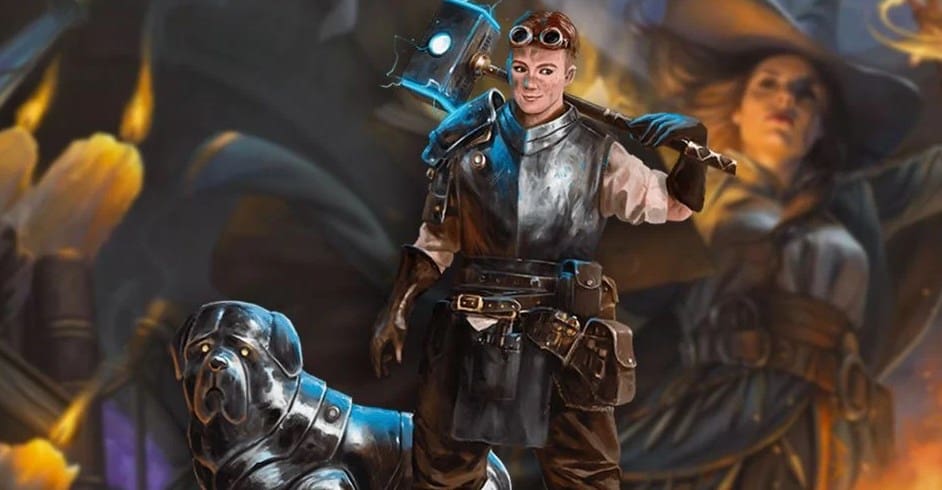
Tasha’s Cauldron of Everything describes Battle Smiths as ‘a combination of protector and medic’.
What tools can Battle Smiths use in 5e?
At the 3rd level, Artificers who choose the Battle Smith specialist gain proficiency with smiths’ tools.
What are the Battle Smith spells in 5e?
- 3rd level: heroism, shield
- 5th level: branding smite, warding bond
- 9th level: an aura of vitality, conjure barrage
- 13th level: an aura of purity, fire shield
- 17th level: banishing smite, mass cure wounds
What abilities do Battle Smiths have?
- At the 3rd level, Battle Smiths gain proficiency with martial weapons and can use their Intelligence modifier (rather than Strength or Dexterity) on attack and damage rolls when using a magic weapon.
- At the 5th level, Battle Smiths can attack twice when they take an attack action.
- At 9th level, you gain Arcane Jolt. If a Battle Smith with a magic weapon or their steel defender (see below) hits an enemy, either that enemy takes an additional 2d6 force damage or one creature of your choice has 2d6 hit points restored.
- At the 15th level, your Arcane Jolt becomes more powerful. The extra damage dealt increases to 4d6 and your steel defender gains +2 to its AC.
What is Battle Smith’s steel defender?
At the 3rd level, Battle Smiths can create a steel defender that follows their orders. The steel defender goes on the same initiative as you but can only take a Dodge action unless you take a bonus action on your turn to command it to do something else. The steel defender can be healed 2d6 hit points using the mending cantrip.
What are the steel defender’s attributes?
The full statistics of Battle Smith’s steel defender can be found in Tasha’s Cauldron of Everything. But here is a brief overview of the steel defender’s core stats:
- 15 AC
- 2 hit points plus your Intelligence modifier
- 40ft speed
What actions can the steel defender take?
If you use a bonus action to command your steel defender, it can take one of the following actions:
- Force-empowered Rend: A melee weapon attack using your spell attack modifier to hit. The hit does 1d8 plus your proficiency bonus worth of force damage.
- Repair: Three times a day the steel defender can restore 2d8 plus your proficiency bonus worth of hit points to itself or a nearby mechanism.
Frequently Asked Questions
Question: What is the best Artificer specialist?
Answer: The Battle Smith is the best Artificer specialist as it has combat and supportive abilities.
Question: What is the best race for Artificers in 5e?
Answer: Any race that grants a bonus to your Intelligence modifier will make a great Artificer. Gnomes make great Artificers. If you’re playing an Eberron campaign, a Warforged Artificer would be a lot of fun! You can find this race in Eberron: Rising from the Last War.
Question: Do specialist spells count towards the Artificer’s prepared spells limit?
Answer: No. Whilst specialist spells do count as Artificer spells, they do not count against the number of Artificer spells that you can prepare at each level.
Final thoughts on Artificers in 5e
Artificers are a unique and complex D&D class. Whilst they probably aren’t the best class to choose if you’re a beginner D&D player, if you feel prepared then there is a lot of fun to be had with this steampunk-inspired class. If you’re committed to playing an Artificer, be sure to pick up a copy of Tasha’s Cauldron of Everything so you have access to the full class details and spell descriptions.
- Best Alternatives to Dungeons & Dragons - August 23, 2023
- Wyverns 5e Guide: The Chickens of the Dragon Family - September 5, 2022
- Best DnD Dice Tray Ideas for Players and DMs - August 22, 2022

